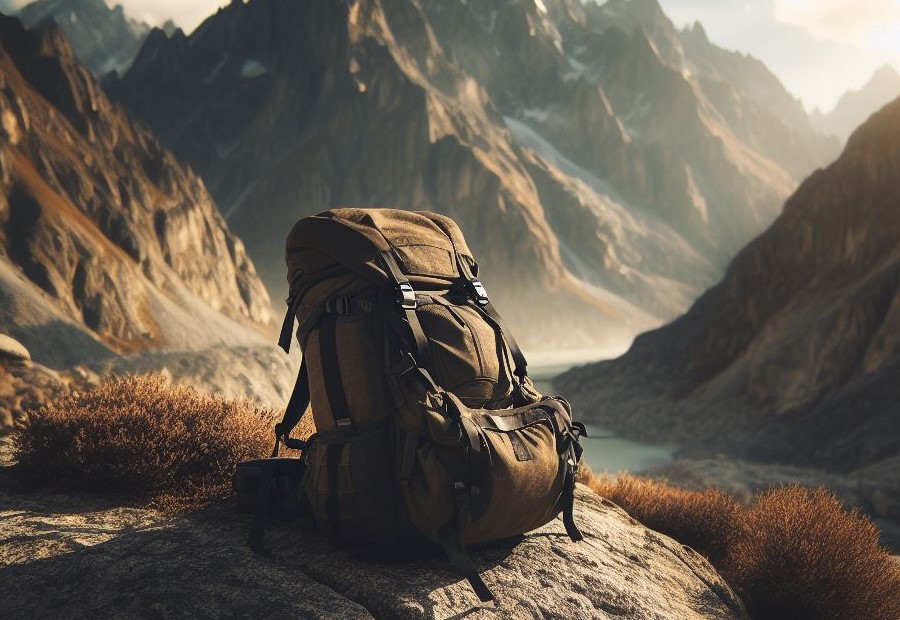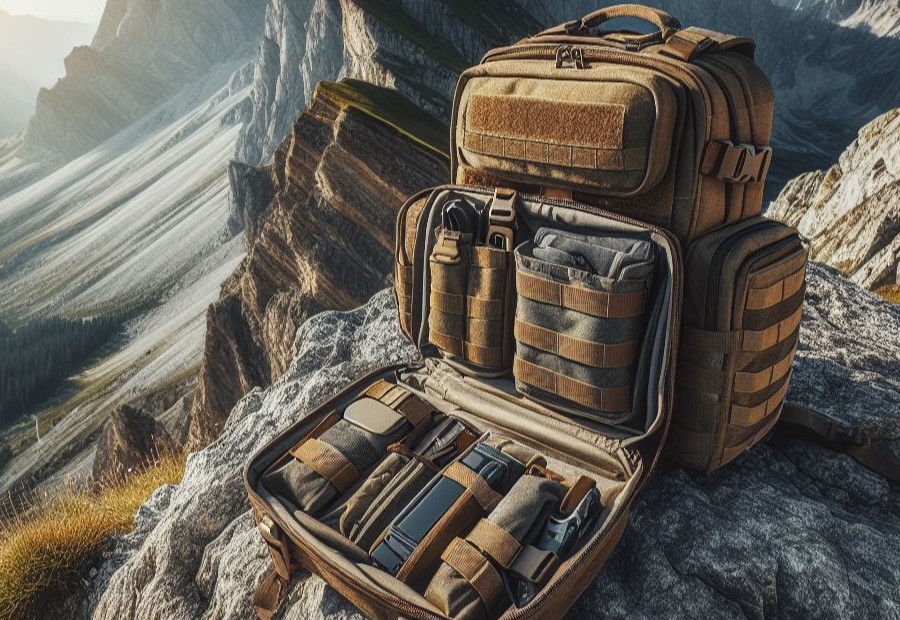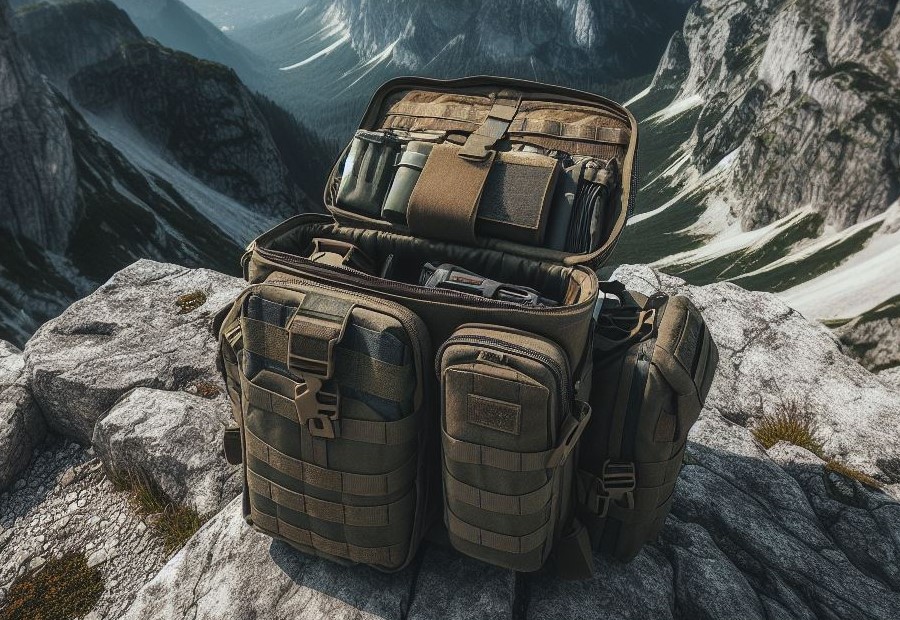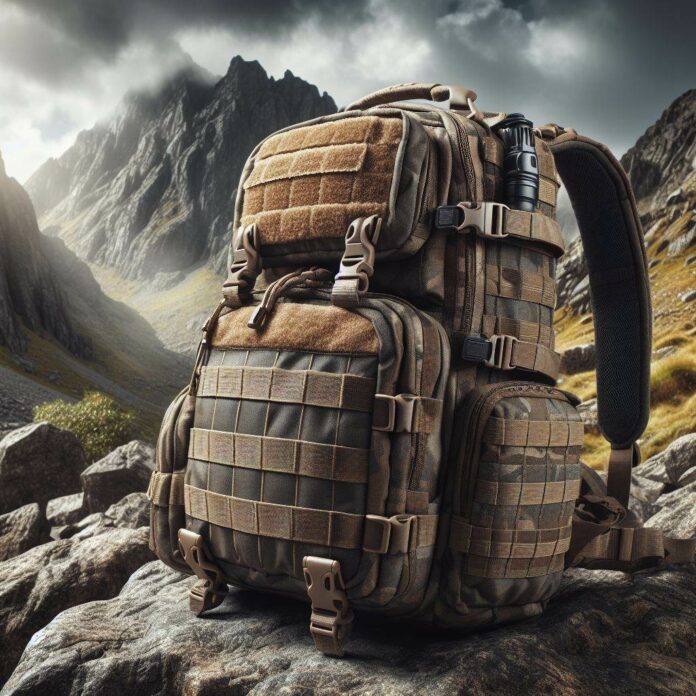A tactical backpack is an essential tool for outdoor enthusiasts, survivalists, and military personnel.
Knowing how to pack a tactical backpack properly is crucial for optimizing its functionality and ensuring you have all the necessary items at your disposal.
In this article, we will explore the key factors to consider when packing a tactical backpack, the essential items to include, and provide a step-by-step guide on efficiently organizing your gear.
We will share valuable tips for optimizing your tactical backpack to meet your specific needs. By following these guidelines, you can maximize the utility and convenience of your tactical backpack for any adventure or emergency situation.
Importance of Packing a Tactical Backpack Properly

Packing a tactical backpack properly is of utmost importance to ensure convenience and efficiency during outdoor activities or emergencies.
- Optimal weight distribution: Properly packing your tactical backpack ensures that the weight is evenly distributed, preventing strain on your back and shoulders.
- Accessibility: Organizing your items in the backpack allows for easy access to essentials in times of need, eliminating the hassle of searching for items when time is of the essence.
- Quick identification: By packing your backpack in an organized manner, you can quickly identify and retrieve the necessary items without wasting time.
- Maximizing storage capacity: Proper packing techniques help maximize the available space in your backpack, allowing you to carry more essential items without compromising comfort or mobility.
- Protection and durability: Properly securing your items inside the backpack ensures their protection from damage or loss during rigorous outdoor activities.
- Efficient monitoring: By organizing your backpack, you can easily monitor your supplies, ensuring that you have everything you need and are prepared for any situation.
- Quick packing and unpacking: Efficiently packed backpacks enable quick and easy packing and unpacking, saving valuable time during emergencies or when on the move.
By considering the importance of packing a tactical backpack properly and incorporating these aspects, you can ensure convenience, accessibility, and preparedness for any outdoor adventure or situation.
Essential Items to Include in a Tactical Backpack

Clothing and Personal Items
When packing a tactical backpack, it is crucial to consider the clothing and personal items you will need for your trip.
These items will ensure your comfort, hygiene, and protection while in the field. Here are some essential clothing and personal items to include in your tactical backpack:
- Extra Clothing: Pack extra sets of clothing suitable for the weather conditions you anticipate. Include items like shirts, pants, socks, and underwear.
- Personal Hygiene Products: Remember to bring toiletries such as toothbrush, toothpaste, soap, shampoo, and toilet paper.
- First Aid Kit: Include a well-stocked first aid kit with bandages, antiseptic wipes, pain relievers, and any necessary prescription medications.
- Weather Protection: Pack items such as a raincoat, sunscreen, hat, and sunglasses to protect yourself from the elements.
- Navigation Tools: Carry a compass, maps, and a GPS device to navigate your surroundings.
Survival and Navigation Tools
When it comes to packing a tactical backpack for survival and navigation, it is important to include the following essential tools: survival and navigation tools.
- A compass: A reliable compass is crucial for navigating through unfamiliar terrain and ensuring you stay on the right path.
- A map: Carry a detailed map of the area you’ll be exploring. It will help you plan your route and find landmarks or important locations.
- A GPS device: While a map and compass can be sufficient, a GPS device can provide precise coordinates and help you track your progress.
- A multi-tool: A versatile tool with various functions like a knife, saw, screwdriver, and pliers can come in handy for various tasks in survival situations.
- An emergency whistle: In case you find yourself in danger or need to attract attention, a whistle can be a lifesaver to alert others to your presence.
- A signaling mirror: This tool can reflect sunlight to catch the attention of rescuers or communicate with others from a distance.
- An LED flashlight: A reliable flashlight is essential for illuminating your path at night or in dark environments.
- A fire starter kit: Being able to start a fire is vital for warmth, cooking, and signaling for help. Include waterproof matches, a lighter, or flint and steel.
- Survival knife: A sturdy and sharp knife can be used for various tasks such as cutting ropes, preparing food, or building shelter.
- Water purification tablets: In emergency situations, having the means to purify water is crucial for preventing dehydration and waterborne illnesses.
First Aid Kit and Medications
When it comes to packing a tactical backpack, one crucial aspect to consider is the inclusion of a first aid kit and medications.
These items are essential for addressing any injuries or medical emergencies that may arise during your expedition. Here are a few key points to keep in mind:
- First Aid Kit: Ensure that your first aid kit contains all the necessary items, including bandages, antiseptic ointment, gauze pads, adhesive tape, tweezers, and pain relief medications.
- Medications: Depending on your specific needs, include any prescription medications, over-the-counter drugs, or essentials like allergy relief, painkillers, and anti-inflammatory medications.
- Proper Organization: Organize your first aid kit and medications in a way that allows for easy access. Utilize gear-specific compartments or zippered pockets to keep them secure and readily available.
- Water-Resistant Protection: It is important to choose a tactical backpack with a water-resistant outer coating or storage sections to ensure that your first aid kit and medications stay dry and protected.
- Regular Inventory Check: Regularly check the expiration dates of your medications and replace any expired items. Also, periodically evaluate your first aid kit to ensure it is fully stocked and meets your specific needs.
- Emergency Preparedness: Familiarize yourself with basic first aid techniques and be prepared to handle common injuries or medical emergencies. Consider taking a first aid course to enhance your knowledge and skills.
Remember, having a well-equipped first aid kit and necessary medications can make a significant difference in addressing injuries or medical conditions promptly, ensuring you stay safe and healthy during your outdoor adventures.
Food and Water Supplies
When packing a tactical backpack, it is crucial to include the necessary food and water supplies to ensure your sustenance and hydration during your outdoor adventures. Here are some essential items to consider:
- Water: Pack enough water to meet your hydration needs for the duration of your trip. Consider carrying a water bladder or bottles with water-resistant outer coatings to prevent leaks.
- Hydration tools: Include a water filter or purification tablets to ensure access to safe drinking water from natural sources if needed.
- Food: Choose lightweight and energy-boosting snacks that are easy to pack and provide essential nutrients. Consider options like protein bars, trail mix, or dehydrated meals that require minimal preparation.
- Cooking equipment: If planning to cook meals, pack a compact stove, pots, and utensils. Opt for lightweight options that are easy to store.
- Food storage: Use zippered bags or waterproof containers to store food and prevent spoilage or contamination.
Remember to consider the duration of your trip and the specific needs of each individual. It’s essential to include food and water supplies to stay well-nourished and hydrated, maintaining your energy levels and overall well-being.
Additionally, ensure proper organization of your food and water supplies within the backpack to optimize space and weight distribution. Taking these factors into account will help you pack efficiently and be prepared during your outdoor adventures.
Communication and Lighting Devices
When it comes to packing a tactical backpack, it’s important to consider the communication and lighting devices you’ll need in order to stay connected and navigate in different situations. Here are some essential devices to include:
- Two-way radios: These communication devices allow for easy communication with others in your group, especially in areas with limited cell service.
- Headlamp: A hands-free lighting option that is essential for nighttime activities or when you need to keep your hands free.
- Flashlight: A portable source of light that can come in handy in emergency situations or when additional lighting is needed.
- Glow sticks: These are lightweight and long-lasting, making them great for marking trails, signaling, or as a backup light source.
- Signal mirror: A small mirror that can be used to signal for help in emergency situations or to communicate over long distances.
An additional pro-tip is to pack extra batteries for your communication and lighting devices. It’s better to be prepared and have backup power in case of emergencies or situations where you’ll be relying on these devices for extended periods of time.
How to Pack a Tactical Backpack
Choose the Right Backpack and Organizational Tools
To select the appropriate backpack and organizational tools for packing a tactical backpack, it is important to go through the following steps:
- Consider your specific needs: Start by determining the purpose of your backpack and the items you will be carrying. Whether it is a long-distance hike, camping trip, or city exploration, identifying your requirements is crucial.
- Look for a backpack with the necessary features: Find a backpack that offers a spacious main storage area, multiple exterior and interior pockets, easily accessible compartments, and convenient grab-and-go handles.
- Choose a durable bag: Opt for a backpack that is constructed with high-quality materials such as ballistic nylon or superior fabrics. Also, ensure the bag has a water-resistant outer coating to safeguard your gear from unfavorable weather conditions.
- Prioritize organization: Consider a backpack that provides proper organization, such as gear-specific compartments, interior mesh pockets, zippered pockets, and MOLLE webbing that allows you to attach additional pouches or equipment.
- Consider comfort level: Look for a backpack equipped with padded shoulder straps, a back panel, and a waist belt to ensure proper weight distribution and enhance your comfort, particularly when carrying heavy items.
By following these steps, you will be able to select a tactical backpack and the appropriate organizational tools that meet your specific needs.
This ensures that you have a well-equipped and organized pack for all your adventures or daily activities.
Pack Heavy Items at the Bottom
To pack heavy items at the bottom of your tactical backpack, follow these steps:
- Empty the contents of your backpack and lay it flat on a clean surface.
- Identify the heavy items that you will be packing, such as camping gear or rock climbing equipment.
- Place a water-resistant outer coating or a waterproof liner at the bottom of your backpack to protect the heavy items from moisture.
- Create a stable base by arranging the heavy items at the bottom of the main storage area. This will help distribute the weight evenly and prevent the backpack from becoming top-heavy.
- If your backpack has gear-specific compartments or pockets, utilize those for organizing and securing the heavy items.
- Consider using compression straps or the 5.11 slickstick® webbing platform to secure the heavy items in place and prevent them from shifting while you’re on the move.
- Make sure that the heavy items are packed tightly to prevent unnecessary movement or shifting, which could throw off the balance of the backpack.
Utilize Compartments and Pockets Efficiently
To effectively utilize compartments and pockets when packing a tactical backpack, follow these steps:
- Start by identifying the specific needs for your trip or activity.
- Prioritize the necessary items and categorize them based on their purpose.
- Utilize the gear-specific compartments and pockets in the backpack to store items that require easy access.
- Organize medium-weight items in the main storage area of the backpack.
- Utilize the interior pockets for smaller gear and essential tools.
- If your backpack has an external frame, use the top and side pockets to store additional items.
- Take advantage of any zippered pockets for added security.
- Make use of compression straps to secure and stabilize the load.
- Distribute weight evenly throughout the backpack to ensure balanced weight distribution and avoid strain on your back.
- Finally, adjust the straps and fit of the backpack to ensure comfort and proper weight distribution.
Distribute Weight Properly
- Start by organizing your gear into categories based on weight and size.
- Place the heaviest items, such as camping gear or rock climbing equipment, at the bottom of the backpack.
- Distribute medium-weight items evenly throughout the middle section of the backpack.
- Store the lightest items, like personal hygiene products or extra clothing, in the top pockets or outer pockets for easy access.
- Utilize the backpack’s compartments and storage sections to keep gear-specific items organized and secure.
- Ensure proper weight distribution by placing heavier items closer to your back, which will help maintain balance and reduce strain on your shoulders and back.
- Consider using compression straps to secure and stabilize the load, preventing excessive movement during activities or while on the move.
- Keep in mind the comfort level of your backpack and make adjustments as necessary, redistributing weight if your back hurts or if the load feels unbalanced.
- Remember to adjust weight distribution throughout the day as you consume food and water supplies, ensuring a comfortable and balanced pack.
Secure and Stabilize the Load
When securing and stabilizing the load in a tactical backpack, follow these steps to ensure everything stays in place:
- Use compression straps to tighten the load and prevent it from shifting during movement.
- Make sure heavy items are packed at the bottom of the backpack to maintain balance.
- Utilize gear-specific compartments or interior pockets to keep items organized and prevent them from bouncing around.
- If necessary, use an external frame backpack for better weight distribution.
- Secure any bulkiest equipment to the outside of the backpack using additional straps.
- Check that the load is properly balanced by adjusting straps and redistributing weight as needed.
- Secure and stabilize the load to ensure comfort and ease of movement during outdoor activities and ensure that necessary items are readily accessible when needed.
Tips for Optimizing Your Tactical Backpack

Selecting Lightweight and Versatile Gear
When it comes to selecting lightweight and versatile gear for your tactical backpack, it is important to prioritize functionality and practicality. Here are some key factors to consider:
- Weight: Opt for gear that is lightweight to minimize the overall weight of your backpack. Look for materials like high-end fabrics or ballistic nylon that offer durability without adding unnecessary bulk.
- Flexibility: Choose gear that can serve multiple purposes. Look for items that can be used in different situations or adapted for various tasks.
- Organization: Ensure that the gear you choose has proper organization options. Look for gear-specific compartments, interior pockets, and external pockets that allow for easy access and efficient packing.
- Compactness: Select gear that can be easily folded or compressed to save space in your backpack. Consider items that offer compression straps or can be rolled up tightly.
- Functionality: Make sure the gear you choose serves an important purpose. Consider the specific needs of your outdoor activities or survival situations and select gear that fulfills those requirements.
By consciously selecting lightweight and versatile gear that meets these criteria, you can ensure that your tactical backpack is efficiently packed and equipped with essential items for your outdoor adventures.
Regularly Reevaluating and Updating Your Pack
To ensure that you are regularly reevaluating and updating your pack, follow these steps:
- Assess your needs: Regularly evaluate the specific needs of your upcoming trips or activities.
- Review your gear: Take inventory of your current gear and assess if any items need to be replaced or upgraded.
- Check for wear and tear: Inspect your backpack for any signs of damage or wear. Replace any worn out straps or buckles.
- Update your packing routine: Adjust your packing routine based on your experiences from previous trips. Identify any items that were unnecessary or items that were missing.
- Consider new equipment: Research and consider new gear that can enhance your pack’s functionality and meet your specific needs.
- Stay up to date: Keep abreast of new gear innovations and advancements in technology that could improve your pack’s performance.
By regularly reevaluating and updating your pack, you can ensure that it is always prepared for your adventures and equipped with the necessary items.
Practice Packing and Adjusting the Load
When it comes to packing and adjusting the load in a tactical backpack, the practice of following these steps can help ensure an efficient and comfortable experience:
- Start by organizing your gear and necessary items before packing.
- Prioritize your gear based on specific needs and the activities you will be undertaking.
- Pack heavy items at the bottom of the backpack to distribute the load evenly.
- Utilize the compartments and pockets efficiently for easy access to essential tools and equipment.
- Distribute the weight properly by placing medium-weight items in the middle section of the backpack.
- Secure and stabilize the load using compression straps and other features to prevent shifting while on the move.
By practicing packing and adjusting the load beforehand and making any necessary adjustments, you can ensure that your tactical backpack is properly packed and that the load is balanced to minimize strain on your back.
Remember to consider the comfort level, weather conditions, and the length of your adventure when determining what items to pack and how to distribute the weight.
Practice packing and adjusting the load beforehand to familiarize yourself with the process and make any necessary adjustments for a smooth and comfortable journey.
Frequently Asked Questions
How do I pack a tactical backpack with a water-resistant outer coating?
To pack a tactical backpack with a water-resistant outer coating, ensure that all your essential items are placed inside waterproof bags or containers.
This will help protect your gear from moisture and ensure they stay dry. Additionally, use the exterior pockets with easy access to store items that are less susceptible to water damage.
What are the benefits of having easy-to-access exterior pockets in a tactical backpack?
Easy-to-access exterior pockets in a tactical backpack allow you to quickly retrieve frequently needed items without having to unpack your entire bag.
They provide convenient storage for items like flashlights, a tactical knife, radios, or a first aid kit, ensuring easy access during emergencies or urgent situations.
How can I utilize the outside compartment of the tactical backpack?
The outside compartment of a tactical backpack can be used to store smaller items that you need to keep accessible.
This can include gear like flashlights, a first aid kit, or other essentials that you may need to quickly grab without having to open your main storage area.
What is meant by the term “militaristic feel” when referring to a tactical backpack?
When a tactical backpack is described as having a “militaristic feel,” it means that it has a design and appearance that resembles military gear.
This can include features like MOLLE webbing, a durable and rugged construction, and color options typically associated with the military, such as OD green, desert tan, or black.
How should I pack the top layer of a tactical backpack?
The top layer of a tactical backpack is best suited for lighter items that you may need to access easily.
This can include items like a change of socks, a poncho, self-defense tools, navigation gear, or small items like snacks and water purification tablets. Placing these lighter items on top ensures that they are readily available when needed.
What are some standard features to look for in a tactical backpack?
Look for standard features such as a roomy main storage area, reinforced grab-and-go handles, exterior pockets with easy access, interior mesh pockets and gear-specific compartments, water-repellent coating, external compression straps, and an internal hydration compartment.

